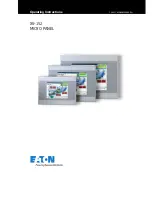
1
Fig. 7: Ethernet interface
1
Ethernet interface
Ethernet interface
The Ethernet interface is located on the controller behind a transparent cover
Ensuring the degree of protection.
The Ethernet interface is used exclusively for accessing the WebConfig interface
for the controller
When a connecting cable is connected to the Ethernet interface, electromagnetic
compatibility is not guaranteed.
Unauthorised access to the device can cause damage or malfunctions.
When connecting the device to a network:
Protect the network against unauthorised access.
Measures to protect the network include:
• Firewall
• Intrusion Prevention System (IPS)
• Network segmentation
• Virtual LAN (VLAN)
• Virtual private Network (VPN)
• Security at physical access level (port security)
For additional information
è
Guidelines and standards for security in information
technology, e. g. IEC 62443, ISO/IEC 27001.
Input modules
CTMM-...-D-...
CTMM-...-A-...
1
+24 V U
SEN
1
+24 V U
SEN
3
0 V U
SEN
2
Input
4
Input
3
0 V U
SEN
4
n. c.
Tab. 8: Pin allocation for input modules
4.1.4.2 Connection elements, pneumatic
Ports for compressed air supply (1) and common exhaust (3) are available both
on the controller and on the right-hand end of the manifold rail. The ports are
internally connected in each case and can be used alternately or in parallel.
When multiple valves are connected simultaneously, the dynamic pressure cre-
ated in the exhaust ducts or the pressure drop in the supply ducts can negatively
affect other applications. When multiple valves are switched simultaneously, pres-
surisation and exhaust are recommended on both sides for an optimised flow rate
and exhaust performance.
1
2
3
5
4
6
7
8
2
3
Fig. 8: Pneumatic ports
1
M7 port for pressure compensa-
tion (L)
2
G3/8 port for common exhaust/
vacuum (3)
3
G3/8 port for compressed air
supply (1)
4
G1/8 ports for working air (2)
5
M7 port for pilot exhaust air (84)
6
G1/8 ports for working air (4)
7
Selector for external pilot air or
blanking plugs for internal pilot
air M5
8
M5 port for external pilot air
(14) or blanking plugs for internal
pilot air
4.2
Function
The function scope of the Motion Terminal VTEM is dependent on the scope of
the licensed Motion Apps. For many Motion Apps, the number of licences required
is based on the desired number of valves on which the Motion App should run
simultaneously. Other Motion Apps, for example, Motion App GAMM-A1 “Direc-
tional control valve functions”, are licensed by default for all valves of the Motion
Terminal.
The parameterisation and behaviour of the Motion Apps can be defined by a
higher-order controller or the integrated WebConfig interface. The details are
described in the manuals for the Motion Terminal and the Motion Apps
Common resources for the entire Motion Terminal system are used for simulta-
neous operation of several Motion Apps. Resulting dependencies are described in
the Application Notes
This product uses open-source software. A list of the licences used is contained in
the manual of the Motion Terminal
4.2.1
Vacuum operation
Only specific Motion Apps are suitable for vacuum use. The Motion Terminal
is supplied with vacuum via the port (3) for common exhaust. Manual of the
corresponding Motion App
4.2.2
Soft-start function
Certain motion apps are equipped with a soft-start function, which prevents
unbraked extending of a drive when cylinder chambers are exhausted. This func-
tion can cause a drive to first move in the opposite direction during system
start-up and before execution of a motion command.
Manual of the corresponding Motion App
4.2.3
Internal and external pilot air supply
The product can be operated with internal or external pilot air, depending on
the configuration ordered. The configuration can also be changed at a later time
11.2 External/internal pilot air.
• The pressure at port (1) must be
>
0.3 MPa (3 bar) for the internal pilot air
supply.
• The pressure at port (14) must be
>
0.3 MPa (3 bar) for the external pilot air
supply.
Mixed operation with internal and external pilot air is not intended.
The pressure at port (1) is monitored by the device. If the pressure at port (1) is
less than 0.3 MPa (3 bar), an external pilot air supply of at least 0.3 MPa (3 bar)
is required; the negative pressure monitoring at (1) must be deactivated via the
corresponding CPX module parameter
1.1 Applicable documents. The device
does not monitor the pressure for port (14).

























